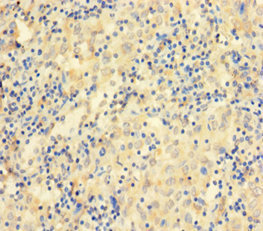CCDC36 Antibody
-
货号:CSB-PA816910LA01HU
-
规格:¥440
-
促销:
-
图片:
-
其他:
产品详情
-
产品名称:Rabbit anti-Homo sapiens (Human) CCDC36 Polyclonal antibody
-
Uniprot No.:Q8IYA8
-
基因名:CCDC36
-
别名:CCDC36 antibody; IHO1Interactor of HORMAD1 protein 1 antibody; Cancer/testis antigen 74 antibody; CT74 antibody; Coiled-coil domain-containing protein 36 antibody
-
宿主:Rabbit
-
反应种属:Human
-
免疫原:Recombinant Human Interactor of HORMAD1 protein 1 protein (11-592AA)
-
免疫原种属:Homo sapiens (Human)
-
标记方式:Non-conjugated
本页面中的产品,CCDC36 Antibody (CSB-PA816910LA01HU),的标记方式是Non-conjugated。对于CCDC36 Antibody,我们还提供其他标记。见下表:
-
克隆类型:Polyclonal
-
抗体亚型:IgG
-
纯化方式:>95%, Protein G purified
-
浓度:It differs from different batches. Please contact us to confirm it.
-
保存缓冲液:Preservative: 0.03% Proclin 300
Constituents: 50% Glycerol, 0.01M PBS, PH 7.4 -
产品提供形式:Liquid
-
应用范围:ELISA, IHC
-
推荐稀释比:
Application Recommended Dilution IHC 1:20-1:200 -
Protocols:
-
储存条件:Upon receipt, store at -20°C or -80°C. Avoid repeated freeze.
-
货期:Basically, we can dispatch the products out in 1-3 working days after receiving your orders. Delivery time maybe differs from different purchasing way or location, please kindly consult your local distributors for specific delivery time.
相关产品
靶点详情
-
功能:Required for DNA double-strand breaks (DSBs) formation in unsynapsed regions during meiotic recombination. Probably acts by forming a complex with MEI4 and REC114, which activates DSBs formation in unsynapsed regions, an essential step to ensure completion of synapsis. Not required for HORMAD1 functions in pairing-independent synaptonemal complex formation, ATR recruitment to unsynapsed axes, meiotic silencing of unsynapsed chromatin (MSUC) or meiotic surveillance.
-
亚细胞定位:Chromosome.
-
数据库链接:
HGNC: 27945
KEGG: hsa:339834
STRING: 9606.ENSP00000296449
UniGene: Hs.631931
Most popular with customers
-
-
YWHAB Recombinant Monoclonal Antibody
Applications: ELISA, WB, IF, FC
Species Reactivity: Human, Mouse, Rat
-
Phospho-YAP1 (S127) Recombinant Monoclonal Antibody
Applications: ELISA, WB, IHC
Species Reactivity: Human
-
-
-
-
-























